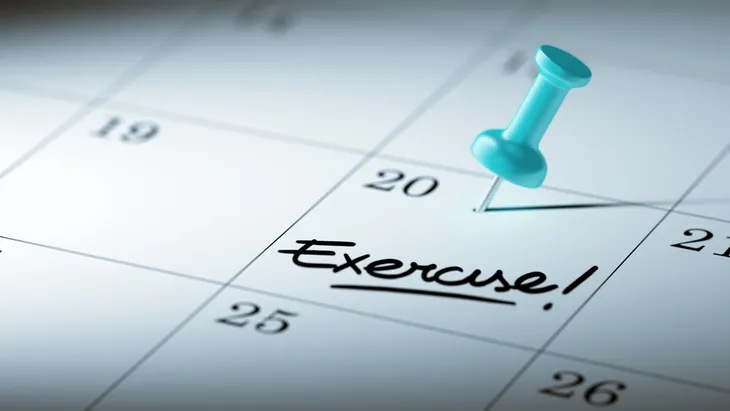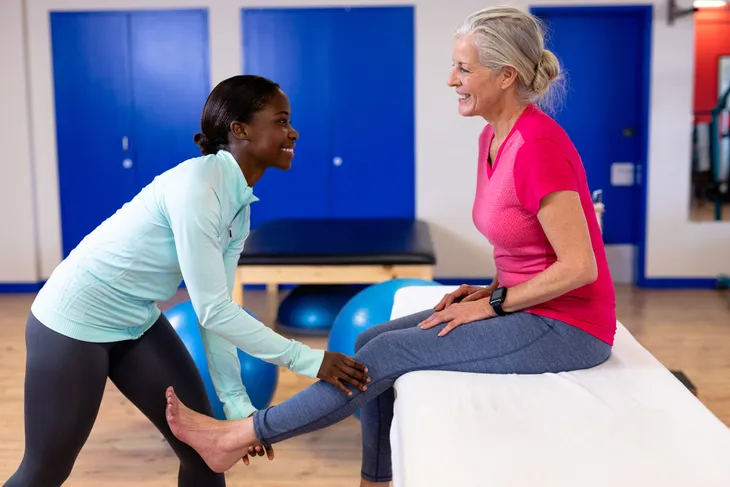- As much as we try to avoid them, exercise injuries are still possible.
- They’re commonly caused by training and technique errors or using improper gear such as poor-fitting running shoes.
- Warming up, practicing proper form, and taking adequate rest days are just a few ways you can help prevent injuries.
Exercise is an important part of a healthy lifestyle. It can help build strength, improve flexibility, reduce stress, and even improve your energy levels. Unfortunately, exercise isn’t without its risks. Injuries are possible and do happen but they’re commonly caused by training and technique errors.
The good news is many causes of exercise injuries are preventable by following a few good practice tips! If you’re new to exercise or want to step up your current routine, check out these 12 tips to prevent exercise injuries.
The Importance of a Warm-Up
While you’ve surely been told before that you really should warm up before working out, many people jump straight into exercise without doing so. Jumping into exercise with cold muscles is an easy way to injure yourself as your muscles are less pliable and more prone to tearing, explains Maryland Orthopedic Specialist.
Dedicate the first 5 to 10-minutes of your workout to a proper warmup to get your blood flowing and your muscles warmed up. Some great ways to do this include walking, controlled dynamic stretches, or lifting light weights.
Don’t Forget the Cool Down
Cooling down after your workout is just as important as a warm-up, especially if you’re engaging in an exercise where your heart rate is elevated. A cool-down can help encourage gradual recovery and bring your heart rate back to resting and your breath back to a normal rhythm. It may also promote relaxation.
Verywell Fit also says skipping a cool down may increase your risk of lightheadedness and dizziness. “Studies have shown that active recovery helps with delaying muscle fatigue and can aid in improved and more efficient workouts,” explains the source. A cool-down should last about 3 to 10-minutes and should include slower gentle movements such as walking.
Practice Proper Form
Another surefire way to get an exercise injury is by using improper form. To prevent injury, it’s imperative that you practice proper form. Pay attention to your posture, and if you’re lifting weights ensure the weight you’re using can be done with proper form too. Proper technique can also improve your performance, says O.S.R Physical Therapy.
To practice proper form watch videos online. You can also consider hiring a personal trainer to help you get started.
Pace Yourself
While you may be excited to get going on your new fitness journey or eager to ramp up your current routine, it’s so important to pace yourself. Don’t overdo it. Training with too much intensity, especially in the beginning, is not only unsustainable but it can be harmful too, explains Verywell Fit.
If you’re new to fitness, the source says to start with moderate exercise for around 20-minutes several times per week. Over time you can gradually increase your workout intensity and duration.
Don’t Push Too Hard
Even though you’re eager to hit the ground running, don’t push too hard. You may have been able to lift heavy weights or run quickly years ago, but trying to jump in too quickly and too hard, can only wreak havoc on your body.
Be realistic with your new goals as well as your abilities. Maryland Orthopedic Specialist says, “A couple of days at a lower intensity while you figure out where your training sweet spot is will do much less to impede your eventual performance than starting off too hard, injuring yourself, and having to take several days or weeks off to recover.”
And remember, proper form is far more important than showing off and lifting an impressive weight. If you can’t utilize the weight with proper form, then you need to start with something less heavy.
Don’t Forget to Drink Water
Drinking enough water is vital for your overall health. It protects your organs and tissues and helps carry essential nutrients and oxygen to your cells. It’s also incredibly important if you want to prevent injury during exercise.
First, water can help lubricate your joints. Drinking water before, during, and after exercise is also important because it replenishes the fluids and electrolytes you lose through sweat when you exercise.
Maryland Orthopedic Specialist also notes that it’s important that you don’t overdo it as too much water can leave you feeling nauseated and distracted during your workout. The source says try drinking 16-ounces of water roughly 2-hours before your workout, sip on water throughout your workout, and drink another 16-ounces within 2-hours after exercising to help replace lost fluids.
Fuel Your Body
Fueling your body with food is just as important as drinking enough water. You shouldn’t work out immediately after a big meal, however, eating a few hours before working out can help provide your body with the energy it needs. How much you eat and when you eat will depend on what type of exercise you’re doing.
As a general rule, Maryland Orthopedic Specialist recommends eating a light, balanced meal or snack about 2-hours before working out. Be sure to eat a snack or meal shortly after your workout too. Finally, don’t forget to eat protein as it helps rebuild muscle fibers
Invest in Proper Gear
Investing in the proper gear for your workouts is so important for preventing injury. If you want to get back into running, you should invest in a good pair of running shoes that support your feet. The Mayo Clinic says you should also replace your shoes every 250 to 500-miles. At the very least, you should replace them twice a year if you exercise regularly, says the source.
Furthermore, if you like to bike outdoors, it’s important to invest in a good helmet and consider a cushioned seat or cushioned cycling shorts. Other types of safety equipment include goggles, skin guards, mouthguards, wrist straps, and elbow or knee sleeves.
Mix-Up Your Routine
Another great way to help prevent injury is to mix up your routine. WebMD explains varying your workout can help prevent you from overusing one set of muscles. “Repeating the same muscle movements frequently can lead to overuse and repetitive-use injuries such as shin splints and tendinitis,” explains the source.
To mix up your workout routine, consider cardio one day and weight training the next. You can also mix in low-impact exercises such as swimming, walking, and biking throughout the week too.
The Importance of Stretching
We already touched on dynamic stretching as a part of a warm-up but stretching, in general, may be important for preventing exercise injuries. Stretching can help keep your muscles flexible, strong, and healthy, and in turn, can help maintain your range of motion in the joints, explains Harvard Health.
Medline Plus says you should dedicate time for stretching at least two times per week. It’s important that you don’t stretch cold muscles so be sure to warm up first. When stretching hold the positions for 15 to 30-seconds and don’t bounce. You should feel tension but not pain. Finally, you can also consider practicing yoga a couple of times per week to stretch your muscles and improve your range of motion.
Know Your Problem Areas
Another way to help prevent exercise injuries is to familiarize yourself with your trouble areas. WebMD says you’ll want to “tailor your workout for problem areas.” This can help build up strength in those areas, however, it’s important that you don’t do exercises that cause you pain.
The best thing to do is to work with your doctor and perhaps a physical therapist to first identify your problem areas and then find out what exercises you should be doing. It’s also vital that you start slow and light and increase as you build strength.
Listen to Your Body and Rest
Listening to your body is key. If your body is fatigued, or you’re feeling sore from your workouts, this may be a good sign that it’s time to take a rest day. Most individuals will need at least 1 to 2-days of rest per week. Allowing your body adequate time to recover can help prevent injuries.
Moreover, rest days don’t have to be spent on the couch doing nothing. If you feel like you need a break from your current routine, but aren’t totally zapped of energy you can take an active rest day, which means you do light exercise such as walking.
What to Do if You Get an Injury
Even if you try your hardest, injuries are still possible. This is why it’s important to know what to do if you get one. WebMD says if you develop an exercise injury follow the RICE method. This stands for:
- Rest the injury.
- Ice the injury to reduce inflammation.
- Compression bandage to minimize swelling.
- Elevate the injury to reduce swelling.
The source notes, most exercise injuries heal on their own in 4-weeks or less. However, if you think your injury is serious see your doctor right away. You should also contact your doctor if the injury hasn’t improved within a week or if it gets worse.
 Shutterstock/Maridav
Shutterstock/Maridav














